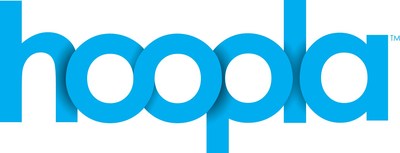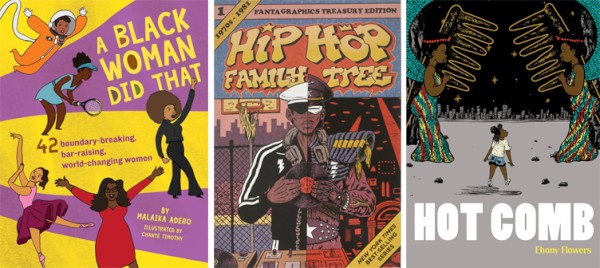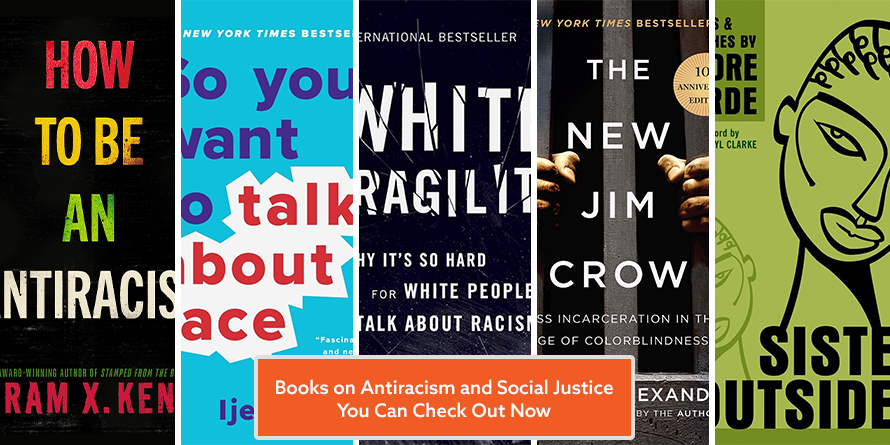
Find books and articles at Skyline College Library with 
About OneSearch
More resources are available from the public libraries in San Mateo County.
Question: Why isn't "white privilege" a Library of Congress subject heading?
This research guide by Santa Clara University Library explains "How Subject Heading Bias Occurs."
We look forward to your recommendations for additional resources to include in Antiracism: A Resource Guide.
Please submit a Research Help Form including your recommendation(s) and any links or comments you choose.
Thank you for helping to build this new Skyline College resource.







By PW Staff | Jun 11, 2020
|
|
 |
In tribute to the memory of George Floyd, who died at the hands of the Minneapolis police, and in support of the worldwide outcry over his death, PW’s comics editors have compiled a list of graphic titles about African American life and history. The titles listed here are primarily nonfiction graphic works that address topics including the Civil Rights Movement, hip-hop, gentrification, white supremacy, the criminal justice system, police brutality, and the lives of black women. In addition the list also offers several works of fiction that offer insights into similar topics via their settings and skillful characterizations. We welcome suggestions for other titles to add to our list.
Black Life and History
A Black Woman Did That by Malaika Adero and Chanté Timothy (Downtown Bookworks)
A lively compilation of illustrated biographical profiles of 42 dynamic black women whose accomplishments have transformed the world, including such figures as Michelle Obama, Ida B. Wells, Serena Williams, Ava DuVernay, and Stacey Adams. For young readers.
Bingo Love by Tee Franklin and Jenn St-Onge (Image).
Hazel and Mari, two black teen girls, meet at a bingo hall in 1963 and fall in love but must hide their feelings and go separate ways, only to accidentally reunite decades later—after marriage and raising children—in a lovingly rendered fictional tale about second chance queer love.
Black History in Its Own Words by Ronald Wimberly (Image)
A collection of inspirational quotations from black leaders and artists throughout American history accompanied by Wimberly’s evocative drawings.
Fist Stick Knife Gun: A Personal History of Violence by Geoffrey Canada with art by Jamar Nicholas (Beacon)
This vivid graphic adaptation of Canada’s acclaimed memoir marks his emotional evolution as he moves through escalating levels of neighborhood violence while growing up poor in the Bronx.
Ghetto Brother: Warrior to Peacemaker by Julian Voloj with art by Claudia Ahlering (NBM)
The true story of Bronx legend Benjy Melendez, son of Puerto-Rican immigrants, who founded the notorious Ghetto Brothers gang in the 1960s before establishing peace between the warring gangs in the 1970s in what was a prelude to the Hip-hop era.
Hip Hop Family Tree by Ed Piskor (Fantagraphics)
This massive 4-volume graphic history of Hip-hop beginning in the 1970s in the Bronx covers four decades of musical, visual, and literary innovation that has transformed music and youth culture around the world.
Hot Comb by Ebony Flowers (Drawn & Quarterly)
Flowers offers a series of poignant and insightful graphic stories that explore the lives of black women, the cultural complexities around their hair, and issues of race and class in the U.S. and in Africa.
Kindred by Octavia Butler, adapted by Damian Duffy and John Jennings (Abrams ComicArts)
Recreated graphically, Butler’s acclaimed 1979 novel tells the story of an -African American woman from the 1970s who travels back in time to slavery and meets an unlikely ancestor.
Nat Turner by Kyle Baker (Abrams)
Baker’s powerful graphic work depicts the life and times of the self-educated African American preacher who led a slave revolt in Southampton County, Va., in 1831, believing that God wanted him to free the slaves.
Sentences: The Life of MF Grimm by Percy Carey and art by Ron Wimberly (Vertigo)
The true story of the life of legendary Hip Hop MC Percy “MF Grimm” from his time as child actor on Sesame Street, then as a drug dealer who uses a wheelchair after a murder attempt, and his eventual rise to become an underground rap star.
Showtime at the Apollo: The Epic Tale of Harlem’s Legendary Theater by Ted Fox and James Otis Smith (Abrams ComicArts)
Fox’s history of the famous venue surveys the personalities and social issues that have impacted the theater and the Harlem neighborhood that surrounds it, over the course of 85 years.
Six Days in Cincinnati: A Graphic Account of the Riots That Shook the Nation a Decade Before Black Lives Matter by Dan Mendez Moore (Microcosm)
An account of an uprising that engulfed Cincinnati in 2001 after 19-year-old Timothy Thomas was killed by the police, as told from the viewpoint of a participant in the civil disobedience.
Strange Fruit: Uncelebrated Narratives from Black History by Joel Christian Gill (Fulcrum). The lives of little known figures in black American history such as Box Brown and Bass Reeves are featured in biographical stories that bring them back to life.
Stuck Rubber Baby by Howard Cruse (First Second).
A pioneering queer/civil rights graphic novel based in-part on Cruse’s life, it is the story of a young gay white man growing up in the Jim Crow south and his complex relationships with queer and straight members of the African American community in the early days of the Civil Rights Movement.
Yummy: the last days of a Southside Shorty by G. Neri and Randy Duburke (Lee and Low)
A YA graphic novel based on the life and death of Robert "Yummy" Sandifer, an 11-year-old gang member from Chicago's Southside who was killed by members of his own gang.
Civil Rights Movement
March Trilogy by John Lewis, Andrew Aydin and Nate Powell (TopShelf)
The three volumes covering the life of Rep. John Lewis offer a gripping and panoramic narrative of the Civil Rights Movement across the arc of Lewis’ heroic social activism and public service.
King: A Comics Biography by Ho Che Anderson (Fantagraphics)
The final deluxe hardcover compilation edition of a pioneering and critically acclaimed graphic biography of Martin Luther King Jr. has been praised for its expansive and creative depiction of King’s life.
Martin Luther King and The Montgomery Story by Fellowship of Reconciliation, Alfred Hassler, Benton Resnick (Fellowship of Reconciliation)
The landmark 16-page 1957 comic book account of the 1955 Montgomery Bus Boycott led by Rosa Parks details the tenets of the philosophy of nonviolence as well as the tactics used to battle Jim Crow segregation on city buses.
Criminal Justice
Big Black: Stand at Attica by Frank “Big Black” Smith and Jared Reinmuth, art by Améziane. (Archaia)
A graphic memoir by the late Frank “Big Black” Smith, a former Attica prison inmate later turned prisoner-rights advocate, who was an inmate leader during the four-day 1971 Attica prison uprising, a landmark event in the history of mass incarceration.
Race to Incarcerate by Marc Mauer with art by Sabrina Jones (New Press)
Maurer and Jones adapt Maurer’s landmark examination of four decades of the explosive and socially corrosive expansion of the American prison population into a graphic work.
The Real Cost of Prisons Comix edited by Lois Ahrens (PM Press)
This anthology of comics looks at the economics, racial disparity, and racist social impact around financing and building prisons.
Race and Social Justice
Black Panther: A Nation Under Our Feet by Ta-Nehesi Coates and Brian Stelfreeze (Marvel) (log in as you would to Canvas).
The classic Marvel black superhero, the Black Panther T’Challa, King of the Afrofuturist African domain of Wakanda, has been reimagined for a new generation by National Book Award –winner Coates.
BTTM FDRS by Ezra Claytan Daniels and Ben Passmore (Fantagraphics)
An irresistible combination of satire and horror in a quirky graphic exploration of urban gentrification, racial tropes, and class among the young and insufferably hip in a former working class Chicago neighborhood.
I Am Alfonso Jones by Tony Media with art by Stacey Robinson and John Jennings (Lee and Low)
This complex and inspirational graphic novel is aimed at young adults and memorializes a number of victims of police violence (among them Eleanor Bumpurs, Amadou Diallo, and writer Henry Dumas), while also probing the issues surrounding police brutality and Black Lives Matter.
Your Black Friend and Other Strangers by Ben Passmore (Silver Sprocket).
These thoughtful and dazzlingly illustrated short stories and graphic essays focus on contemporary responses to race, prisons, police brutality, gentrification, radical politics, and more.


For Adults 

Antiracist Pedagogy Reading List, compiled by Andrea Aebersold, director of faculty instructional development in the Division of Teaching Excellence and Innovation at the University of California at Irvine.
Antiracist Pedagogy Reading List
Compiled by Andrea Aebersold, Ph.D - University of California, Irvine
*This is a working document with the goal of better understanding antiracist pedagogy in higher education. Sources will continue to be added. Email andrea.aebersold@uci.edu with additional sources. Please feel free to share this document.
Amico, R.P. (2016). Antiracist Teaching. New York: Routledge.
Baldwin, J. (1963, December 21) “A Talk to Teachers.” The Saturday Review, 42-44.
Case, K.A. (2013). Deconstructing Privilege: Teaching and Learning as Allies in the Classroom. New York: Routledge
Case, K. A. (Ed.) (2017). Intersectional pedagogy: Complicating identity and social justice. New York: Routledge/Taylor & Francis Group
DeLong, R., Coleman, T., DeVore, K.S., Gibney, S., Kuhne, M., & Déus, V. (2019). Working Toward Racial Equity in First-Year Composition. New York: Routledge.
Douglass Horsford, S., Grosland, T. J., and Morgan Gunn, K. (2011). Pedagogy of the Personal and Professional: Considering Culturally Relevant and Anti-Racist Pedagogy as a Framework for Culturally Relevant Leadership. Journal of School Leadership, 21 (4).
Freire, P. (2000). Pedagogy of the Oppressed. New York: Continuum
hooks, b. (1994) Teaching to Transgress: Education as the Practice of Freedom. New York: Routledge
Howell, A. & Tuitt, F. (2003) Race and Higher Education: Rethinking Pedagogy in Diverse College Classrooms. Cambridge: Harvard Educational Review
Jenkins, C. (2016). Addressing white privilege in higher education. Academic Exchange Quarterly, 20(4), 121-126. Retrieved from http://hdl.handle.net/1969.1/158792
Jenkins, C. M. (2018). Educators, question your level of cultural responsiveness. Journal on Empowering Teaching Excellence, 2(2), 15-23. https://digitalcommons.usu.edu/jete/vol2/iss2/4
Jenkins, C. (2018). Intersectional considerations in teaching diversity. In Carter, N & Vavrus, M. (Eds.), Intersectionalities of Race, Class, and Gender with Teaching and Teacher Education: Movement Toward Equity in Education. Leiden. The Netherlands: Brill/Sense. DOI: https://doi.org/10.1163/9789004365209_003
Jenkins, C., & Alfred, M. (2018). Understanding the motivation and transformation of White culturally responsive professors. Journal of Adult and Continuing Education, 24(1), 81-99. https://doi.org/10.1177/1477971417738793
Kailin, J. (2002). Antiracist education: From theory to practice. New York: Rowman & Littlefield Publishers, Inc
Lawrence, S. M. & Tatum, B. (1997). Teachers in transition: The impact of antiracist professional development on classroom practice. Teachers College Record, 99, 162–180
McNair, T.B., Bensimon, E.M. & Malcolm-Piqueux, l. (2020) From Equity Talk to Equity Walk: Expanding Practitioner Knowledge for Racial Justice in Higher Education. Hoboken: Jossey-Bass.
Phillips, C.B. & Derman-Sparks, L. (1997). Teaching/Learning Anti-Racism: A Developmental Approach. New York: Teachers College Press.
Sue, D. W. (2015) Race Talk and the Conspiracy of Silence: Understanding and Facilitating Difficult Dialogues on Race. Hoboken, NJ: Wiley
Tuitt, F., Haynes, C. & Stewart, S. (Eds.), (2016). Race, equity, and the learning environment: The global relevance of critical and inclusive pedagogies in higher education. Sterling, VA: Stylus
Other Sources
11 Ways White America Avoids Taking Responsibility for its Racism
A Guide to Coded Language in Education
White Supremacy Culture in Organizations
Alexander, M. (2020 - updated edition) The New Jim Crow: Mass Incarceration in the Age of Colorblindness. New York: The New Press
DiAngelo, R. (2018). White Fragility: Why It’s So Hard for White People to Talk About Racism. Boston: Beacon Press
Kendi, I.X. (2019). How to Be an Antiracist. New York: One World
Kendi, I.X. (2017). Stamped From the Beginning: The Definitive History of Racist Ideas in America. New York: Bold Type Books
Oluo, I. (2019). So You Want to Talk About Race? New York: Seal Press.
Saad, L.F. (2020). Me and White Supremacy: Combat Racism, Change the World, and Become a Good Ancestor. Naperville: Sourcebooks
Tatum, B.D. (2017). Why Are All the Black Kids Sitting Together in the Cafeteria?: And Other Conversations About Race. New York: Basic Books.